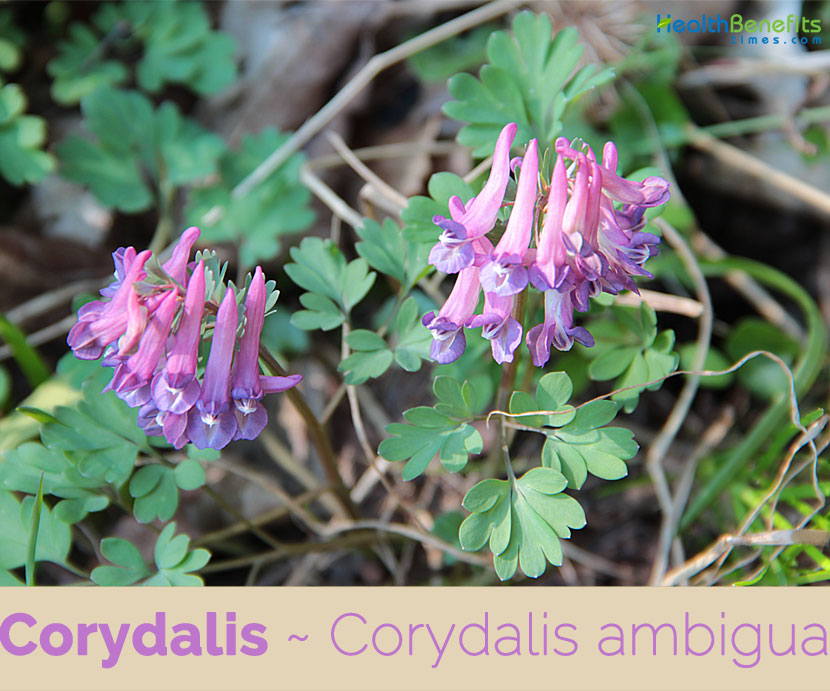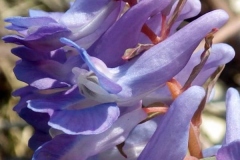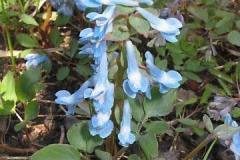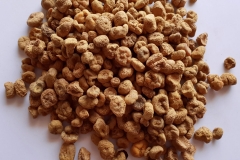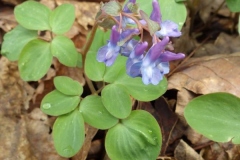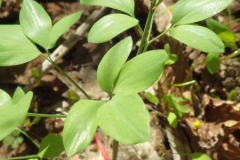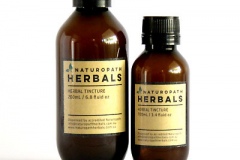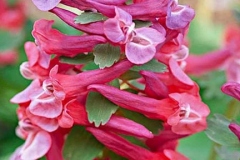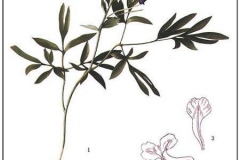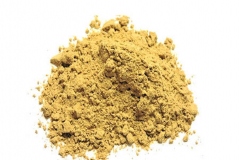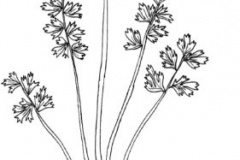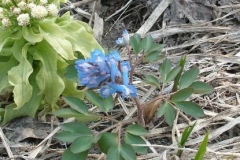| Corydalis Quick Facts | |
|---|---|
| Name: | Corydalis |
| Scientific Name: | Corydalis ambigua |
| Taste | Acrid, Bitter |
| Health benefits | Injuries, Cardiovascular health, Pain relief, Nervousness and insomnia, Inflammation, Insomnia, Gastrointestinal infection, Cataracts, Menorrhagia, Allergy |
| Name | Corydalis |
|---|---|
| Scientific Name | Corydalis ambigua |
| Native | Siberia, northern China, and Japan, it is commonly grown in eastern and northeastern parts of China. |
| Common Names | Ezo-Engosaku, Hsuan Hu So, Yen Hu So, Yan Hu Suo |
| Name in Other Languages | Azb: یالانچی ماهمیزلاله Azerbaijani: Yalançı mahmızlalə Chinese: Yan Hu Suo, dōng běi yán hú suǒ (东北延胡索) Japanese: Ezo-engo-saku (エゾエンゴサク) Russian: Dikiy kartofel’ (дикий картофель), tamtai (тамтай), khokhlatka obmanchivaya (хохлатка обманчивая), khokhlatka somnitel’naya (хохлатка сомнительная) |
| Plant Growth Habit | Small tuberous, herbaceous, perennial plant |
| Growing Climates | Woods, meadows from the lowland to the mountains, spring ephemeral in woodland, shady forest edge, edges of forests or woodland gardens |
| Soil | Prefers a moist, well-drained rather light soil, thriving in semi-shade |
| Plant Size | 8 in (20 cm) |
| In Leaf | March to June |
| Leaf | Scale-like leaf at the bottom, two leaves on the flowering stems |
| Flower | Flowers are hermaphrodite (have both male and female organs) |
| Seed | Black, smooth and shiny |
| Available Forms | Tea, a tincture or a decoction |
| Propagation | By seeds |
| Plant Parts Used | Tuberous Rhizome, root, tuber |
| Taste | Acrid, Bitter |
| Season | May to June |
| Health Benefits |
|
Plant Description
Corydalis is a small tuberous, herbaceous, perennial plant that normally grows about 8 in (20 cm) tall. The plant is found growing in woods, meadows from the lowland to the mountains, spring ephemeral in woodland, shady forest edge, edges of forests or woodland gardens. The plant prefers a moist, well-drained rather light soil, thriving in semi-shade. Scale-like leaf is present at the bottom and two leaves on the flowering stems. Plants are in leaf from March to June. Flowers are hermaphrodite (have both male and female organs). The plant propagated from seed in early spring or autumn, and the rhizome is harvested in late spring and early summer when the aerial parts have withered. Root or rhizome of the herb is dried out and subsequently sliced into cutaways and is made use of in herbal medications.
Research in China from the 1950s onward has shown that corydalis has useful pain relieving properties. The powdered rhizome has up to one-tenth of the analgesic potency of morphine — an alkaloid derived from opium poppy (Papaver somniferum,). Morphine is highly concentrated and the strongest analgesic in medical use. Although this research shows corydalis to be much weaker in its effect than morphine, it nonetheless indicates the value of corydalis in pain relief.
Health benefits of Corydalis
The Rhizome of the Corydalis ambigua plant has been used for thousands of years in traditional Chinese medicine for its pain relieving properties. Rhizome is just a type of root that spreads horizontally underground putting out stem and leaf above ground from its little nodes. This rhizome is dried and used in decoction with water or made into an alcohol tincture. Apart from pain relief, this herb has amazing benefits to the nervous system and the cardiovascular system, just have a look below
1. Injuries
In Chinese medical theory, and in other herbal traditions, pain is often thought to stem from obstruction of normal blood flow. As corydalis is supposed to “invigorate the blood,” it is considered to be especially useful as a treatment for the pain that results from a traumatic injury.
2. Cardiovascular
It’s known as a blood moving herb, so helps with circulatory problems, sticky blood as well as the pain that blood stability can cause. It has traditionally been used to treat heart arrhythmia and palpitations and even shows promise in the reducing the size and occurrence of myocardial infarction (heart attacks). Corydalis acts peripherally to help lower blood pressure.
3. Pain relief
Corydalis is a star in the herbal world for pain relief. Rhizome of the plant is considered best for pain relief in traditional Chinese medicine. It is said to have between 1-10% the analgesic potency of opium, without any of the addictive side effects. It’s known as an analgesic and used most successfully for visceral (internal organ) pain, and pain associated with the nervous system caused by injury or trauma.
When mixed with cinnamon bark it is very effective for dysmenorrhea (painful periods) and mixed with St John’s wort for neuro-pathic pain. It can also be used for most internal pain such as abdominal pain, endometriosis, chest pain, hernia pain, and headaches.
4. Nervousness and insomnia
Corydalis is especially effective in treating nervousness, sleeplessness and restless leg syndrome. The tranquilizing properties of this herb make it a useful medication in treating insomnia and nervousness. Additionally, the potent alkaloids enclosed by the plant boost the sleep-stimulating essence of the barbiturates, which is around 40 per cent as effective as morphine as far as encouraging sleep is concerned. In America, herbal medicine practitioners combine corydalis with California poppy to cure anxiety, restlessness, sleeplessness and edginess.
5. Inflammation
Corydalis is also known to help with chronic and acute inflammation taken orally so has applications in helping the symptoms of pelvic inflammatory disease, arthritis and other chronic inflammatory illnesses. It can also be used topically in an ointment for relief in arthritis, sprains, and other aches and pains in the body.
6. Insomnia
Corydalis is also known as an effective treatment for insomnia without any grogginess or a hangover in the morning. It assists in falling asleep and staying asleep through the night. It could be mixed with rhizome of valerian or Passionflower for a powerful sleep combination.
7. Gastrointestinal infection
The plant is quite effective in treating infected stomach ulcers and infections caused by parasites. Corydalis shows an anti–ulcer activity with no remarkable side effects. The constituent found in Corydalis is responsible for this anti-peptic ulcer action is called dehydro-corydaline and may reduce the H. pylori infection that causes the ulcers. It may also be useful in the treatment of the infection caused by Echinococcus granulosus that comes from the Hydatid worm.
8. Cataracts
Corydalis has been found to be extremely useful in preventing as well as treating cataracts. Alcohol extracted from the corydalis root prevents the development of cataracts related with diabetes.
9. Menorrhagia
The plant is known to help with the reduction in menstrual flow (menorrhagia) so it is considered wonderful for heavy painful menstrual bleeding. Adding ginger root and cinnamon to the decoction or infusing St John’s wort in after turning off heat, will show wonderful benefits.
10. Allergy
Dehydrocorydaline, an element extracted from the corydalis rhizome, slows down the allergic reactions caused due to the intervening of antibodies. According to scientists, the action of the corydalis tuber in slowing down allergic reactions is partly credited to the alkaloidal element dehydrocorydaline.
Traditional uses and benefits of Corydalis
- The plant is alterative, antiperiodic, astringent, deobstruent, diuretic, emmenogogue, sedative, tonic.
- The root is analgesic, antispasmodic and sedative.
- Tuber has a history of over a thousand years use in mitigating pain.
- Corydalis possesses soothing, narcotic and tranquilizing properties and is commonly used to alleviate abdominal pains.
- It has been extensively used for centuries to lend a hand in stimulating the circulatory system as well as alleviate nearly all agonizing conditions.
- Herb is particularly recommended by herbal medicine practitioners to mitigate menstrual cramps, chest and abdominal soreness.
- Root of the corydalis herb possesses palliative or pain relieving, tranquilizing, anti-septic and anti-spasmodic properties.
- Herb is related to the treatment of the heart, liver and spleen.
- Many Chinese herbal medicine practitioners also use the herb to lower blood pressure.
- Root of the herb has been conventionally recommended to relieve pains as well as reinforce the circulation system for hundreds of years.
- Root of the herb is effectively used to treat a number of physical conditions, such as dysmenorrhea, hernia, chest pains, lumbago as well as harrowing injuries.
- As the herb encloses a compound that depresses the central nervous system, it should be used carefully when you are consuming alcohol.
- It can be used with white peony, cramp bark and valerian for menstrual cramping, pain relief and insomnia.
- It is used to treat cases of mild mental disorders such as emotional disturbance and depression as well as limb tremors and nerve damage.
Dosing considerations for Corydalis
Appropriate dose of corydalis depends on several factors such as the user’s age, health, and several other conditions. At this time there is not enough scientific information to determine an appropriate range of doses for corydalis. Keep in mind that natural products are not always necessarily safe and dosages can be important. Be sure to follow relevant directions on product labels and consult your pharmacist or physician or other healthcare professional before using.
Precautions
- Corydalis species are potentially toxic in moderate doses.
- Avoid use during Pregnancy and breastfeeding.
- It may cause dizziness, fatigue and Nausea.
- Excess use may cause drowsiness and abdominal diseases.
- It should not be used by people with an irregular heart rhythm.
- It may also have some interactions with medications such as hypnotics, sedatives, cancer medications and anti-arrhythmic drugs.
References:
https://pfaf.org/user/Plant.aspx?LatinName=Corydalis+ambigua
https://en.wikipedia.org/wiki/Corydalis_ambigua
https://npgsweb.ars-grin.gov/gringlobal/taxonomydetail.aspx?id=403065
http://www.theplantlist.org/tpl1.1/record/kew-2738428


